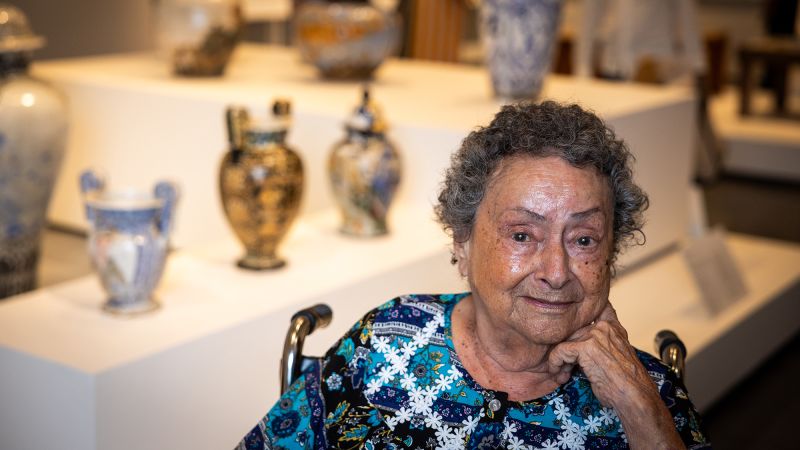Los Angeles
CNN
—
In a new show at the Los Angeles County Museum of Art (LACMA), the zany work of a nonagenarian ceramicist with a mischievous eye delivers a refreshing twist on traditions in pottery.
Magdalena Suarez Frimkess is an anarchic cartoonist in clay: in a career spanning more than half a century, the Venezuelan-born artist has created everyday objects decorated with irreverent images of Mickey Mouse (running around the rim of a soup bowl), Donald Duck (looking guilty), and Olive Oyl (being thrown to the sharks). In 2015, she made a full tea set featuring Looney Tunes’ demented Tasmanian Devil.
“Magdalena Suarez Frimkess: The Finest Disregard” finds the artist enjoying her first major solo show at the tender age of 95. Suarez Frimkess — who lives near Venice Beach in Los Angeles with her husband, the celebrated American potter Michael Frimkess — has riffed on popular American iconography, from Betty Boop and Bugs Bunny to Wonder Woman and Felix the Cat, as well as Chilean comic characters, such as Condorito the anthropomorphic condor. She has decorated vases with likenesses of Miles Davis, Fidel Castro and Martin Luther King.
Considering her medium and subject matter, Suarez Frimkess sits art-historically somewhere between Grayson Perry and Andy Warhol. Sometimes her compositions are whimsical and nostalgic, other times they are unsettling and a little sinister. But such classifications feel wholly inappropriate to this unique body of work. Suarez Frimkess herself calls her aesthetic “serious and funny at the same time.”
The light-hearted nature of her pieces belies a complex biography. Magdalena was born in 1929 in Maturín in the east coast of Venezuala into a working-class family. Aged nine, she was sent to a Catholic orphanage following the death of her mother to tuberculosis. There the nuns soon recognised her love of — and talent for — drawing and painting.
She studied at the prestigious Escuela de Artes Plásticas de Caracas under prominent artists such as the Portuguese painter Rafael Ramon González. In her late teens, she moved to Santiago, Chile, with her married lover. There, she raised their two children, while also studying and teaching art at the city’s Pontifical Catholic University. Experimenting with abstract and surreal sculptures, she created a series of works in which she filled pantyhose with plaster. “It was a bit sexual, like a dream,” she acknowledged. The Catholic faculty was not happy.

She met Michael Frimkess in 1963, while on a fellowship residency at Clay Art Center in Port Chester, New York. They moved together to California the following year, married and began their creative life together, both working with clay, but in very different ways. Her cartoon pieces began in the late 1970s. With these and other works, Suarez Frimkess began exploring the absurdities of the commonplace. “I don’t have a goal. I just play it day by day,” she explained. “It’s like eating, you have to eat every day.”
This is the disregard of the show’s title: Suarez Frimkess dismisses any notion of what is right or wrong in her craft. Similarly, she has rejected the potter’s wheel and has little interest in glazes. Her pieces have the rough-hewn qualities of a school project.
While her cartoon-themed works are prominent at LACMA, the exhibition highlights a broader, but consistently sassy, talent: there are saucers decorated with cockroaches, frogs and toucans; boxes with Mayan and pre-Columbian designs; and compositions on paper and clay in which lines of text are repeated in the style of a teacher’s punishment.

There is autobiography here — a self-portrait of her cycling around Venice circles a vase — as well as satire. One ceramic tile features a row of library bookshelves, labelled variously: “Self Help”, “Self-Improvement” and “Ok Just as You Are”. Art should be fun, the artist once remarked. “If not, it’s not worthwhile.” Her studio, she believes, is the “one secure place” in which she can misbehave.
Also exhibited are collaborations between Suarez and her husband, in which Michael threw vases, pots and jars in a classical style and Magdalena decorated them in an unconventional one. “In their collaborative works, his vessels became irregular and deeply strange through Magdalena’s wayward embrace of pop imagery and personal portraiture,” notes art historian Jenni Sorkin in the exhibition catalogue.
Essentially, Michael brought rigour to the pieces, Magdalena brought wackiness. The retrospective pays tribute to a creative and enduring marriage — fashioned by disruption as well as tenderness — and the bridging of her two nationalities, one ancient, the other modern. But most of all it provides a window into the world of an irrepressibly animated artist quite unlike any other.


